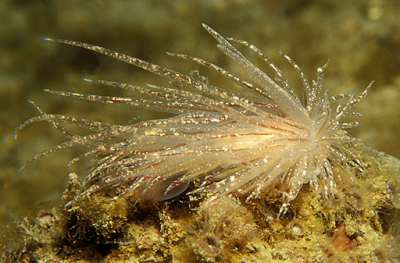
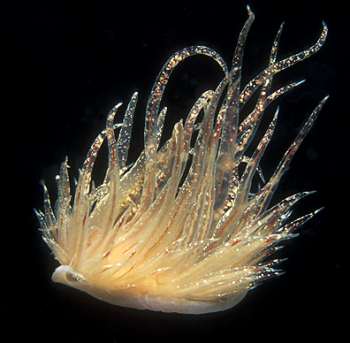
Cumanotus beaumonti
(Eliot, 1906)
Order: NUDIBRANCHIA
Suborder: AEOLIDINA
Family: Cumanotidae
DISTRIBUTION
Known only from British Isles and Norway. Reported in Forum from Mediterranean (Slovenia, Adriatic Sea).
PHOTO
Punta Piran,, Slovenia, northern Adriatic Sea. Depth: 12 m. Length: 3 cm. February 2005. rocky infralittoral. Lower photo showing animal swimming. Photographer: Borut Furlan.
The body is broad and translucent with white and gold speckling covering the head, back and cerata. The long, slender cerata are arranged in 8 to 12 transverse ridges with 6 to 9 cerata in each ridge. The three anterior ceratal ridges are situated in front of the very long, smooth rhinophores. The digestive gland in the cerata ranges from brown to reddish pink. The ceratal wall is translucent clear with gold and white speckling and white tips. The head is broad with distinctive tentacular anterior foot corners. The oral tentacles are short, but distinct.
Two species of Cumanotus have been described from the northeastern Atlantic, and both are considered to be quite rare. One species, Cumanotus cuenoti Pruvot-Fol, 1948, was described from the Atlantic coast of southern France, and the other, Cumanotus beaumonti (Eliot, 1906) is known from the British Isles and Norway.
Whether the two species are distinct is difficult to say, as our knowledge of each is based on very few specimens. Thompson & Brown (1984) note that C. cuenoti appears to be smaller, not exceeding 10 mm in length, lacking oral and propodial tentacles, and having fewer denticles on the radular teeth. C. beaumonti is reported to reach 20 mm in length and Picton & Morrow (1994) report it to swim, as do Tardy & Gantes (1980) for C. cuenoti. Cumanotus cuenoti feeds on Tubularia, and Ectopleura dumortieri (see Tardy & Gantes, 1980) and C. beaumonti feeds on Corymorpha nutans (see Picton & Morrow, 1994).
Photos of C. beaumonti in Picton & Morrow (1994) and Bernard Picton's website, look almost identical to this animal from the Mediterranean. It has previously only been reported from the British Isles and Norway, where it is considered to be very rare. It would suggest the species has a much wider distribution and the rare finds in the northern Atlantic, may suggest a geographic range centered much further south. It is also possible that C. cuenoti is a synonym.
-
Eliot, C.N.E. (1906) Notes on some British nudibranchs. Journal of the Marine Biological Association, United Kingdom 7(3), 333-382, Pls.11-12.
-
Picton, B. E. (1991) Cumanotus beaumonti (Eliot, 1906), a nudibranch adapted for life in a shallow sandy habitat? Malacologia 32: 219-222.
-
Picton, B. E. and Morrow, C. C. (1994) A Field Guide to the Nudibranchs of the British Isles. London, Immel Publishing Ltd. 143pp.
-
Pruvot-Fol,A (1948): Deux aeolidiens d'Arcachon. Journal de Conchyliologie 88(3), 97-100
-
Tardy J. & Gantes H. 1980. Un Mollusque Nudibranche peu connu : Cumanotus cuenoti A. Pruvot-Fol, (1948) ; redescription, biologie. Bulletin de la Société zoologique de France, 105: 199-207.
-
Thompson, T.E. & Brown, G.H. (1984) Biology of Opisthobranch Molluscs, Vol 2. 229pp. 41 Pls., Ray Society: London
Rudman, W.B., 2005 (April 11) Cumanotus beaumonti (Eliot, 1906) . [In] Sea Slug Forum. Australian Museum, Sydney. Available from http://www.seaslugforum.net/find/cumabeau
Related messages
Cumanotus beaumonti feeds on Tubularia
April 21, 2010
From: Dominique Horst
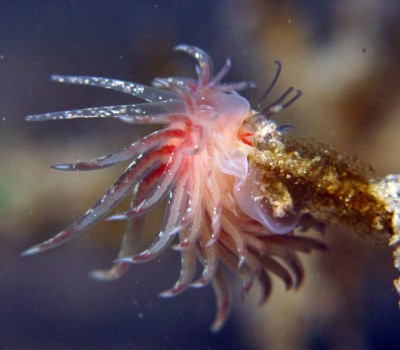
Concerning message #23523:
Dear Bill,
Finally, I have just taken some photos which show without doubt that Cumanotus beaumonti feeds on Tubularia
Locality: Cagnes, 8m, France, Mediterranean sea, 19 April 2010, sand. Photographer: Dominique Horst.
Kind regards,
Dominique
dominique.horst@wanadoo.fr
Horst, D., 2010 (Apr 21) Cumanotus beaumonti feeds on Tubularia. [Message in] Sea Slug Forum. Australian Museum, Sydney. Available from http://www.seaslugforum.net/find/23540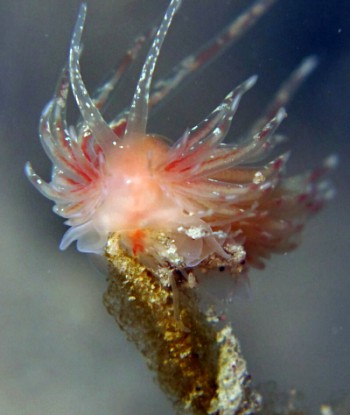
Thanks Dom,
Perseverance certainly pays off.
Best wishes,
Bill Rudman
Cumanotus beaumonti burrowing and swimming
April 20, 2010
From: Dominique Horst
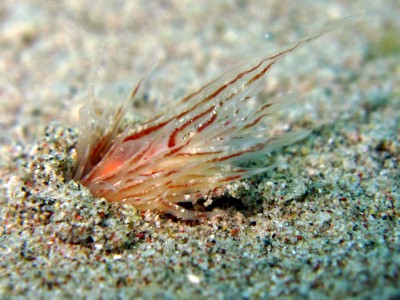
Dear Bill,
This is my final message about Cumanotus beaumonti - at least for the present [see #23522; #23523; #23524]. They burrow into the sand when danger is coming and appear to stay buried during the day except when mating. At night they were in the Tubularia.
I can confirm that they swim well. I've made short video that show it. Unfortunately photo do not show this sequence correctly.
Locality: Cagnes, 8 m, France, Mediterranean sea, 17/04/2010, sand. Photographer: Dominique Horst.
Kind regards,
Dominique
dominique.horst@wanadoo.fr
Horst, D., 2010 (Apr 20) Cumanotus beaumonti burrowing and swimming. [Message in] Sea Slug Forum. Australian Museum, Sydney. Available from http://www.seaslugforum.net/find/23525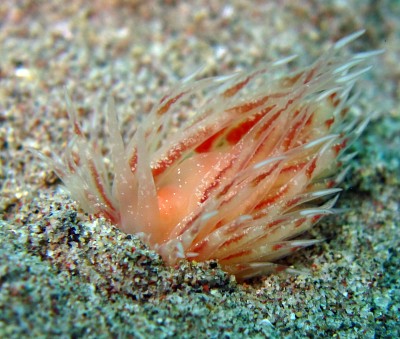
Dear Dom,
Bernard Picton suggested this species might be adapted to a burrowing existence, and this fits well with your observations. Thanks again for this interesting set of messages
- Picton, B. E. (1991) Cumanotus beaumonti (Eliot, 1906), a nudibranch adapted for life in a shallow sandy habitat? Malacologia 32: 219-222.
Best wishes,
Bill Rudman
Cumanotus beaumonti - reproduction
April 20, 2010
From: Dominique Horst
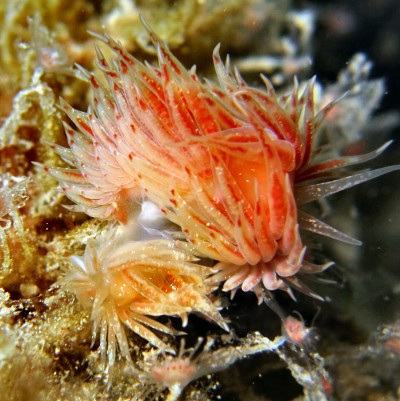
Dear Bill,
An interesting time - Cumanotus beaumonti mating. I think one is laying eggs, but since Facelina annulicornis was also present, I can't really say who is the owner of the different egg masses.
Locality: Cagnes, 8 m, France, Mediterranean sea, 17 April 2010, sand. Photographer: Dominique Horst.
Kind regards,
Dominique
dominique.horst@wanadoo.fr
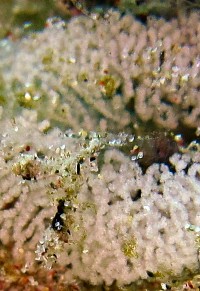
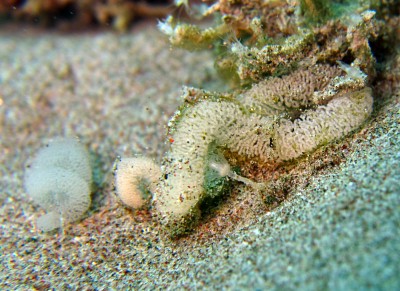
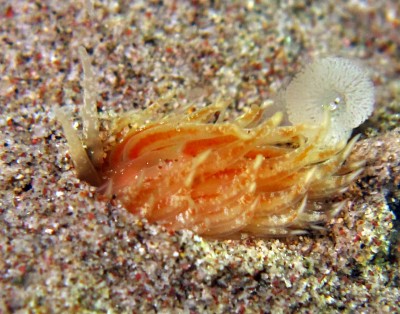
Dear Dom,
I am not sure of the shape of the egg mass of Facelina annulicornis but we have an earlier photo from Italy [message #16466] of a very similar egg mass with Cumanotus, so my guess is that this is the egg mass of Cumanotus. Interestingly animals that live in sand and other soft sediments often have an egg mass like this with a single terminal attachment point. There is little point in having an egg ribbon that needs to be stuck down along one edge when you have only loose sand grains to stick it to. For example there is a photo of the sand-dweller Bullina lineata [message #8822] laying its very similar egg mass which is also attached by a deep anchoring thread at one end
Best wishes,
Bill Rudman
Cumanotus beaumonti feeding
April 20, 2010
From: Dominique HORST
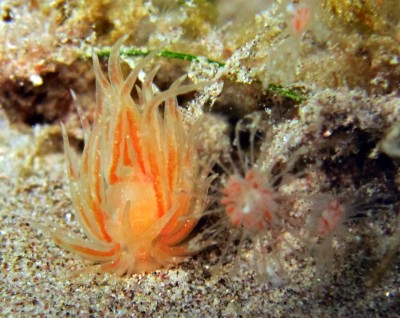
Dear Bill,
These photos suggest that Cumanotus beaumonti feeds on Tubularia (T. indivisa). As in the case of Facelina annulicornis which is supposed is feeding on the same hydroids, I did not capture an actual act of feeding. Doubts are still there but if this is not their food, what else could it be?
Locality: Cagnes, 8m, France, Mediterranean sea, 17 April 2010, sand. Photographer: Dominique Horst.
Kind regards,
Dominique
dominique.horst@wanadoo.fr
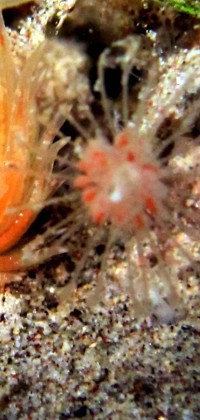
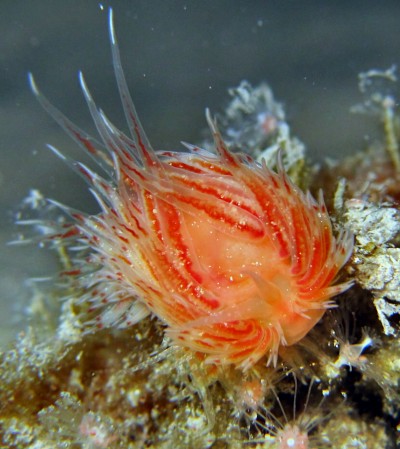
Dear Dom,
If you look at the earlier messages this Cumanotus has almost always been associated with athecate hydroids. To my untutored eye they all look tubularian to me [Tubularia sp, Ectopleura sp], and although you didn't actually catch them in the act of feeding, the regular association with these hydroids and the dark orange-red pigment in the ceratal digestive gland matching the colour in the hydroid polyps is pretty close to conclusive evidence.
Bernard Picton has reported that C. beaumonti in the British Isles feeds on the hydroid Corymorpha nutans. This is another athecate hydroid from the same Order as Tubularia.
Best wishes,
Bill Rudman
Cumanotus beaumonti from the French Mediteranean
April 20, 2010
From: Dominique Horst
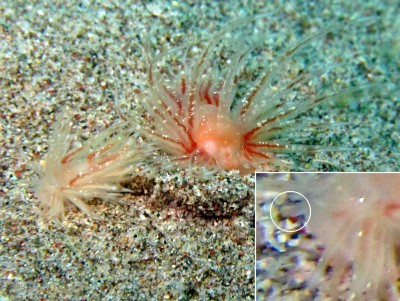
Dear Bill,
I think this is Cumanotus beaumonti. Oral tentacles are visible, but not obviously on the juvenile...?
Not sure if this is any help on the debate about C. beaumonti vs C. cuenoti
The biggest was more than 20 mm long.
I have photos of feeding, food and reproduction in three following messages [#23523; #23524; #23525].
Locality: Cagnes, 8 m, France, Mediterranean sea, 17 April 2010, sand. Photographer: Dominique Horst.
Thanks and kind regards,
Dominique
dominique.horst@wanadoo.fr
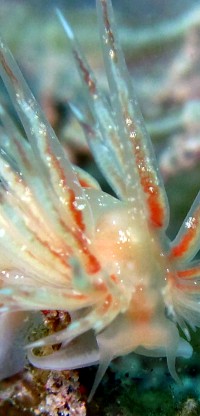
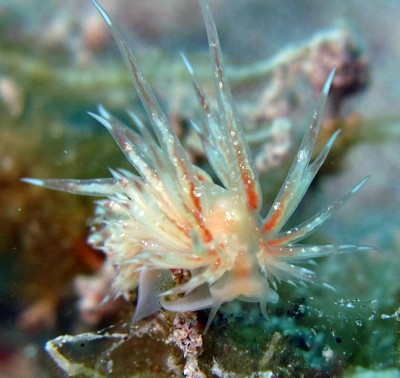
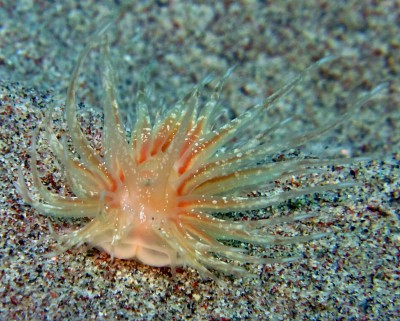
Dear Dom,
Information on species of Cumanotus is very welcome. Thanks for this and the other 3 messages.
Certainly the clear pictures of the oral tentacles and tentacular foot corners in your animal suggest that it is the north Atlantic C. beaumonti rather than the mediterranean C. cuenoti which was described as lacking such tentacles. It is hard to see if your juvenile has tentacles or not - I have ringed a possible oral tentacle in the little close-up. As I have discussed before it is possible that the the tentacles are not developed in juveniles and Mediterranean and Atlantic populations are one species.
Best wishes,
Bill Rudman
Re: Cumanotus from Slovenia [2]
February 25, 2009
From: Sandrine Bielecki
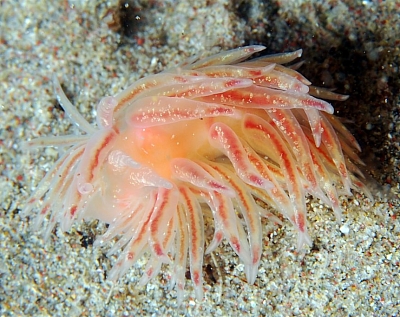
Concerning message #13517:
Hi all
If it can help, Here is a photo of Cumatonus beaumonti (? I think), found in Cagnes sur Mer (South of France) last February 13. The slug was hidden in the middle of hydroid (see picture) which must be its favorite food. It was during a night dive, 7 meters deep and the temperature is around 12°C at this period of the year. The size is around 1 cm.
Locality: Cagnes sur Mer, 7 meters, France, Mediterranee, 13 February 2009, sand. Length: 1 cm. Photographer: Gilles Cavignaux.
Sandrine Bielecki
sandrine.b3@free.fr
Bielecki, S., 2009 (Feb 25) Re: Cumanotus from Slovenia [2]. [Message in] Sea Slug Forum. Australian Museum, Sydney. Available from http://www.seaslugforum.net/find/22268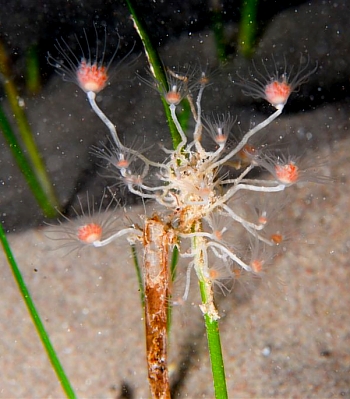
Dear Sandrine,
As you will have seen from the discussion accompanying earlier messages, there is some confusion concerning C. beaumonti and C. cuenoti. Only the latter is reported to feed on the hydroid Tubularia - which I suspect is what you found your animal on - but the shape of the animal suggests it is C. beaumonti. It is not an easy matter to sort out because both 'species' seem to be quite rare. I would agree with your decision to identify this as C. beaumonti although I can't see the oral tentacles which would confirm this.
Best wishes,
Bill Rudman
Re: Cumanotus beaumonti and C. cuenoti
May 13, 2006
From: Cristian Magnani
Concerning message #16580:
Dear Bill
the hydroid in my pictures is Pink mouth Hydroid Tubularia crocea Agassiz, 1862
Best wishes
Cristian
info@nudibranchi.it
Magnani, C., 2006 (May 13) Re: Cumanotus beaumonti and C. cuenoti. [Message in] Sea Slug Forum. Australian Museum, Sydney. Available from http://www.seaslugforum.net/find/16602Dear Cristian,
Thanks very much for checking that out. Marina Poddubetskaia has also sent some more valuable information on her C. cuenoti [see message #16599]. Best wishes,
Bill Rudman
Cumanotus beaumonti swimming
May 11, 2006
From: Cristian Magnani
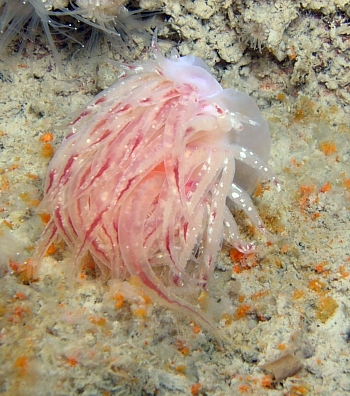
Concerning message #16575:
Dear Bill
Here is a photo of Cumanotus beaumonti swimming. I remember now that when I moved the Cumanotus to get a better picture it actively swam by waving its body and cerata.
Locality: Paguro Shipwreck, 20, Italy, Adriatic sea, 25 April 2006, wreck. Length: 4 cm. Photographer: Cristian Magnani.
Best wishes
Cristian
info@nudibranchi.it
info@nudibranchi.it
Magnani, C., 2006 (May 11) Cumanotus beaumonti swimming. [Message in] Sea Slug Forum. Australian Museum, Sydney. Available from http://www.seaslugforum.net/find/16580Thanks Cristian,
With your help we've have quickly learnt a lot about this rarely observed nudibranch.
Best wishes,
Bill Rudman
Re: Cumanotus beaumonti from Italy
May 11, 2006
From: Cristian Magnani
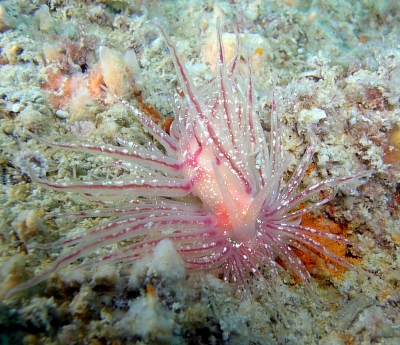
Concerning message #16466:
Dear Bill
I wish to add some more information about my Cumanotus in order to get a better knowledge of this wonderful animal. In my earlier message I've written it was 3 cm but I would say it was bigger in size, reaching at least 4 cm.
Secondly, when I moved a specimen to get a better picture I remember now that it actively swam by waving its body and cerata [see message #16580]. It also releases some of its cerata in autotomy when touched.
On that occasion I saw two small oral tentacles on the head. You can see them in a pair of attached pictures, being white in color while the cerata are more pinkish. Please note also that the red pattern on the back is very similar to the one in Marina Poddubetskaia's photos of Cumanotus cuenoti.
I've emailed Dr. Massimo Ponti who works at a research project on this restricted diving area and he wasn't able to confirm the hydroid was E. dumortieri, so i do agree with your guess about Tubularia. Of one thing I am sure - there are no solitary hydroids on the sunken rig, simply the mud cover on the structure is too thin to allow the growth of this kind of hydroid
I wish also to say that the dive area where I spotted this nudibranch is only 150 km from Capo Piran, Slovenia, where it was previously seen [message #13477]. I hope this further information may be helpful.
Locality: Paguro Shipwreck, 20, Italy, Adriatic sea, 25 April 2006, wreck. Length: 4 cm. Photographer: Cristian Magnani.
Thanks again
Best wishes
Cristian
info@nudibranchi.it
info@nudibranchi.it
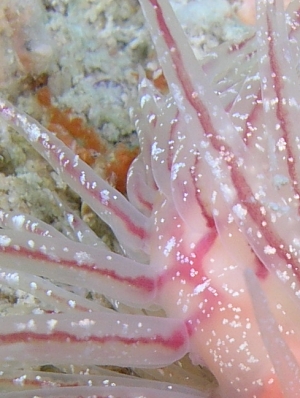
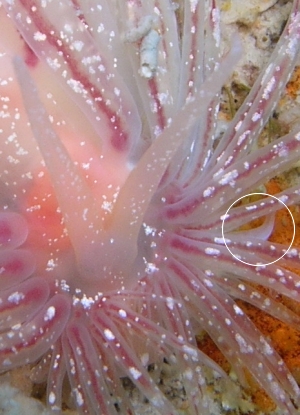
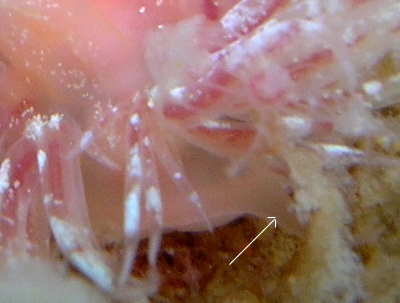
Dear Cristian,
The extra information has certainly confirmed your animal to be C. beaumonti as that is the only species with oral tentacles and tentacle-like extensions on the anterior corners of the foot. The middle right photo shows what could either be an oral tentacle or a tentacular foot corner, and the lower right photo clearly shows an oral tentacle. The colour pattern on the back you mention as being the same as in Marina's photos is caused by the coloured contents of the ducts which run back from the stomach to each of the cerata. The reddish core up the middle of each ceras is the digestive gland, which in molluscs is the part of the body which produces the digestive juices and absorbs the food - a mixture of our liver and intestine.
What would be very interesting would be to find some small animals on your shipwreck, or even in the general area. It would be nice to know if juveniles have oral tentacles or not. If they do not, then C. cuenoti, which is characterised by the lack of oral tentacles, could be just a juvenile of C. beaumonti. The other alternative is for Marina to keep a watch out for the next appearance of her C. cuenoti population and see if they stay small sized or grow much larger. If they grew larger and grew tentacles then I would say there is little doubt that C. beaumonti and C. cuenoti are the same species.
Best wishes,
Bill Rudman
Re: Cumanotus beaumonti from Italy
May 10, 2006
From: Philip Cromwell
Concerning message #16466:
Dear Bill,
I think the following excerpt from your reply should reference C. cuenoti, rather than C. beaumonti:
"As mentioned earlier, C. beaumonti is apparently smaller, not exceeding 10 mm in length, and lacks oral and propodial tentacles. ....."
Regards,
Phil
chiron42@sbcglobal.net
Cromwell, P., 2006 (May 10) Re: Cumanotus beaumonti from Italy. [Message in] Sea Slug Forum. Australian Museum, Sydney. Available from http://www.seaslugforum.net/find/16574Dear Phil,
Thanks for spotting that. I've changed it in the original message but included your message in case someone has already copied my mistake as 'the truth'.
Best wishes,
Bill Rudman
Cumanotus beaumonti from Italy
May 10, 2006
From: Cristian Magnani
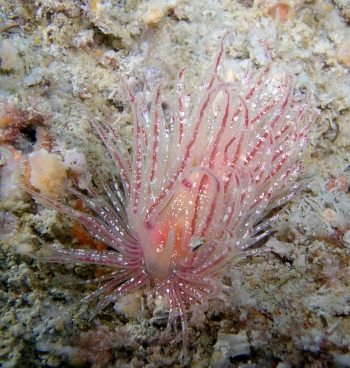
Dear Bill
Recently I was diving on a sunken oil rig out of Ravenna on the Italian Adriatic Coast when I found several Cumanotus beaumonti. It is the very first time I have seen them and I am sure it is the first season they breed here because i dive this spot on regular basis and never saw this slugs before. I send you a couple of pictures of the slug and its eggs.
Locality: Paguro wreck, 20, Italy, Adriatic Sea, 25 April 2006, On Hydroids. Length: 2,5 cm. Photographer: Cristian Magnani.
Best regards
Cristian
cristianmagnani@hotmail.com

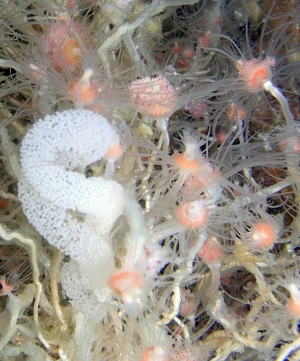
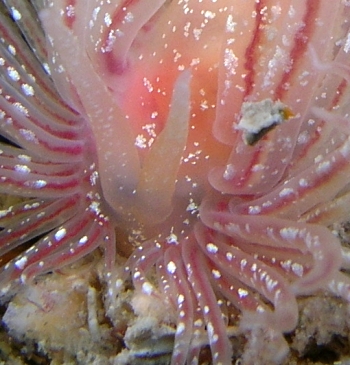
Dear Cristian,
This is an interesting find. As you will see from earlier messages, there are some problems about the northeastern Atlantic species of this genus, Cumanotus beaumonti and Cumanotus cuenoti, both of which have been considered quite rare. As mentioned earlier, C. cuenoti is apparently smaller, not exceeding 10 mm in length, and lacks oral and propodial tentacles. It also has fewer denticles on the radular teeth. It feeds on Tubularia, and Ectopleura dumortieri while C. beaumonti is reported to feed on Corymorpha nutans, a solitary athecate hydroid. Your animal is certainly not feeding on a solitary hydroid, though it is athecate, and I would guess it is a species of Tubularia. Which brings me to Marina Poddubetskaia's photos [message #13507] of Cumanotus cuenoti in which she identifies the food hydroid as Ectopleura dumortieri. I am under the impression that E. dumortieri is a solitary hydroid, so it is likely that the hydroid in her photo is a species of Tubularia rather then Ectopleura. I don't know in the long run whether these food differences are really significant because all three names refer to closely related athecate hydroids all in the same family [Fam: Tubulariidae].
Which brings us back to anatomical differences. You wouldn't by chance have a photo of your Cumanotus showing its head more clearly would you? The only real difference I can find in the literature is that C. cuenoti is said to lack oral tentacles and tentacles at the corners of the anterior edge of the foot. As luck would have it, your photo doesn't show this area clearly.
In summary, I would agree that your animal is C. beaumonti. If so, we can then say that it feeds on Tubularia, just like C. cuenoti, which suggests to me we are one step closer to showing that C. cuenoti is just a juvenile of C. beaumonti.
Best wishes,
Bill Rudman
Cumanotus from Slovenia [2]
April 13, 2005
From: Tom Turk
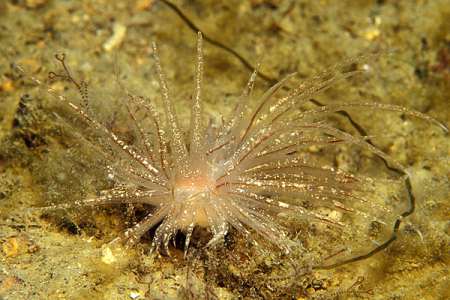
I agree that the two specimens of Cumanotus from Europe (the smaller one from France and a larger one from Slovenia) are, at least visually, two different species. The cerata from the specimen from Slovenia are much longer and the animal foot was measuring about 3 cm in length. For the specimen from Slovenia I am almost convinced that it feeds on Corymorpha nutans since many of them were seen in the near vicinity of the two slugs. Since the pictures were taken in the mid winter (February) when the sea temperature usually reaches its annual lows in northern Adriatic (only about 6-8 oC, making it the coldest part of Mediterranean) I am quite convinced that this Cumanotus is a boreal species that can only exist in Mediterranean in its coldest parts for a very brief period of the year. These animals were never seen before, probably also because not many divers venture in the cold winter sea. The second reason for appearance of Cumanotus in this waters may be the availability of its prefered food which is to be Corymorpha nutans. C. nutans is not present every year in our waters, but the last couple of years is quite abundant. I am attaching an additional picture of Cumanotus from the same location. This picture was taken from the front side, making the head more visible.
Locality: Punta Piran, Slovenia, northern Adriatic. Depth: 20 m. Length: 3 cm (with cerata aprox. 5 cm). February 2005. mixed bottom (muddy, detritic, fine gravel). Photographer: Borut Furlan
Tom Turk
tom.turk@bf.uni-lj
Turk, T., 2005 (Apr 13) Cumanotus from Slovenia [2]. [Message in] Sea Slug Forum. Australian Museum, Sydney. Available from http://www.seaslugforum.net/find/13517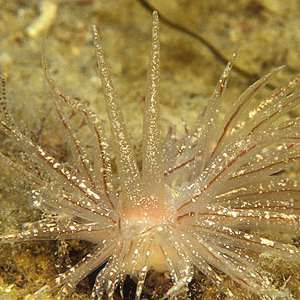
Dear Tom,
Thanks for the extra photo. It is very tantalising. In Thompson & Brown's (1984) drawing of Cumanotus beaumonti there is a distinct pair of oral tentacles and tentacular anterior foot corners, both lacking in C. cuenoti. Unfortunately, although Borut's latest photo is head on, the cerata, which seem to extend all around the front of the head, obscure our view of the actual head. It only illustrates how little we know about both these 'species' at present.
Best wishes,
Bill Rudman
Re: Cumanotus from Slovenia
April 12, 2005
From: Tom Turk
Dear Bill,
I was delighted with your identification of the slug as a species of Cumanotus [message #13477]. Obviously, it is the first description for the Mediterranean sea. I made some additional inquires with Borut (photographer). He told me that he found another specimen on the muddy bottom at 20 depth. I will send you the pictures of this specimen when I receive the scans. He had also told me that there were plenty of Corymorpha nutans in the vicinity. The picture of the first specimen that you posted on the forum as a close up had not been taken at the original position since the photographer transfered it to the near rocks in order to get a better picture. Therefore, the Epizoanthus sp. nearby has nothing to do with the slug's diet.
Best regards,
Tom Turk
tom.turk@bf.uni-lj.si
Turk, T., 2005 (Apr 12) Re: Cumanotus from Slovenia. [Message in] Sea Slug Forum. Australian Museum, Sydney. Available from http://www.seaslugforum.net/find/13493Dear Tom,
Thanks for the extra information. I look forward to seeing the photos of the other specimen. You will see I have just received message [#13507] from Marina Poddubetskaia with photos of Cumanotus cuenoti from Arcachon in France. So we know have colour photographs of the two European species of Cumanotus, both considered rare, on the Forum.
Best wishes,
Bill Rudman
Cumanotus from Slovenia
April 11, 2005
From: Tom Turk


I suspect the specimen is Facelina dubia. Unfortunately the head of the slug is not clearly visible, so the characteristic long tentacles could not be seen. Could you help with positive identification. Pictures were taken in mid winter, the temperature of the water was only about 8 oC.
Locality: Punta Piran,, Slovenia, northern Adriatic Sea. Depth: 12 m. Length: 3 cm. February 2005. rocky infralitoral. Photographer: Borut Furlan
Tom Turk
tom.turk@bf.uni-lj.si
Turk, T., 2005 (Apr 11) Cumanotus from Slovenia. [Message in] Sea Slug Forum. Australian Museum, Sydney. Available from http://www.seaslugforum.net/find/13477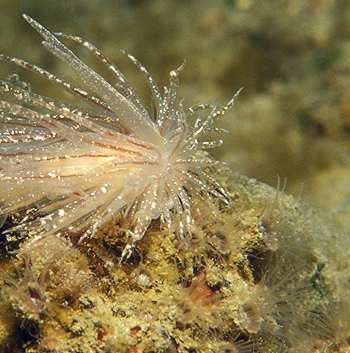
Dear Tom,
Although its long cerata are reminiscent of Facelina dubia, I think this is a much more interesting find. I am pretty sure its a species of Cumanotus. Two species have been described from the Atlantic region, and both are considered to be quite rare. One species, Cumanotus cuenoti Pruvot-Fol, 1948, was described from the Atlantic coast of southern France, and the other, Cumanotus beaumonti (Eliot, 1906) is known from the British Isles and Norway.
Whether the two species are distinct is difficult to say as our knowledge of each is based on very few specimens. Thompson & Brown (1984) note that C. cuenoti appears to be smaller, not exceeding 10 mm in length, lacking oral and propodial tentacles, and having fewer denticles on the radular teeth. C. beaumonti is reported to reach 20 mm in length and Picton & Morrow (1994) report it to swim, as do Tardy & Gantes (1980) for C. cuenoti. Cumanotus cuenoti feeds on Tubularia, and Ectopleura dumortieri (see Tardy & Gantes, 1980) and C. beaumonti feeds on Corymorpha nutans (see Picton & Morrow, 1994). I have added a closeup of part of one of your photos alongside as it shows some anemone-like cnidarians. It would be interesting to know what they are and if your animal is feeding on them
Photos of C. beaumonti in Picton & Morrow (1994) and Bernard Picton's website, look almost identical to your animal. It has previously only been reported from the British Isles and Norway, where it is considered to be very rare. If your animal is indeed the same species, it would suggest the species has a much wider distribution and the rare finds in the northern Atlantic, may suggest a geographic range centered much further south. It is also possible that C. cuenoti is a synonym.
If you find this species again, it would be very interesting to get photos of the head region.
-
Eliot, C.N.E. (1906) Notes on some British nudibranchs. Journal of the Marine Biological Association, United Kingdom 7(3), 333-382, Pls.11-12.
-
Picton, B. E. (1991) Cumanotus beaumonti (Eliot, 1906), a nudibranch adapted for life in a shallow sandy habitat? Malacologia 32: 219-222.
-
Picton, B. E. and Morrow, C. C. (1994) A Field Guide to the Nudibranchs of the British Isles. London, Immel Publishing Ltd. 143pp.
-
Pruvot-Fol,A (1948): Deux aeolidiens d'Arcachon. Journal de Conchyliologie 88(3), 97-100
-
Tardy J. & Gantes H. 1980. Un Mollusque Nudibranche peu connu : Cumanotus cuenoti A. Pruvot-Fol, (1948) ; redescription, biologie. Bulletin de la Société zoologique de France, 105: 199-207.
-
Thompson, T.E. & Brown, G.H. (1984) Biology of Opisthobranch Molluscs, Vol 2. 229pp. 41 Pls., Ray Society: London
Best wishes,
Bill Rudman
